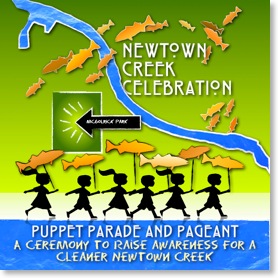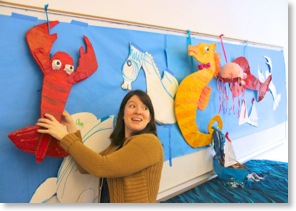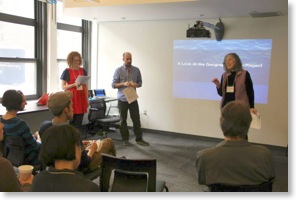5 Discoveries About Presenting Applied Theater Work At An Academic Conference
Saturday, March 23, 2013 | Filed in: Newtown Creek Celebration

Written by Heather Nielsen, Kevin Ray, and Sherry Teitelbaum
On March 17th, Everybody Act! teaching artists Heather Nielsen, Kevin Ray, and Sherry Teitelbaum returned to our alma mater, The CUNY School of Professional Studies, to make a presentation at the Masters in Applied Theatre program’s inaugural Applied Theatre Lab Conference. Our presentation, Community Celebration, Pollution and Puppets: Developing and Implementing an Applied Theater Project, was a case study of the 2012 planning and implementation of Newtown Creek Celebration: Puppet Parade and Pageant. The presentation touched on every phase of the project, from pitching it to potential community partners, to identifying potential funding sources and securing grant support, to balancing our creative vision with the dynamics that our youth participants brought to the table. In this blog post, we share discoveries we made as we overcame some of the challenges we encountered in presenting our applied theater work.
The Project In Brief

Setting the Stage for Discovery in Practice
Presenting applied theater work in a conference setting presents challenges since the fieldwork encompasses multiple components (e.g. community engagement, arts instruction, qualitative outcomes etc.) That being said, we had to be selective about which components to focus on rather than attempt to present the whole panoply of the project. To that end we endeavored to address the following questions:
- From creative inspiration to project implementation, what does a real-world timeline look like?
- How do applied theater practitioners identify community partners and potential funding sources?
- Who were the participants in the project and what voice did they have in the creation of the performance?
1. How Do You Get To The Conference Hall? Practice, Practice, Practice.
Initially, our presentation was scheduled for October 2012. However, Mother Nature had other things in mind and the entire conference was postponed due to Hurricane Sandy’s impact on New York City. When the conference committee rescheduled the event for March 2013, we were happy to participate since we had already planned our session in the fall. Yet on second view, we realized our session was crammed with too much content and too many activities. We met again to trim it to the essentials by referencing our designated outcomes and considering the essential question: What knowledge did we want our session participants to walk away with? We scheduled additional planning sessions to edit our presentation, and contacted the conference committee to secure additional rehearsal time in the room prior to our presentation. Luckily, we were scheduled first in the day and the committee could accommodate us.
2. A Puppet in Hand is Worth A Thousand Words

3. Put On A Show, Or Two!
Applied theater is intrinsically interactive; we are always looking for ways to engage our participants through drama. Although our session was primarily presentational, we felt it was essential to include theatrical elements to underline key moments that would help participants retain important information. To achieve this, we began our presentation with a short puppet show using fish puppets built by the youth during the project. The puppet show introduced the underlying problem (the pollution of the creek), showed how the team of applied theater practitioners came together, and identified each team member’s unique assets. In another dramatic moment, we acted out our varied attempts to meet three different community partners to the sound of a ticking clock. The sound of the clock helped to show that our efforts to secure a community partner were time constrained as we only had two weeks to find a partner before our grant application was due! Not only was the scene fun to perform, it gave participants an easy entry point to the intimidating problem of responding to a request for proposal by using humor.
4. Three Heads Are Better Than One Slideshow

5. Reflect After the Session
Reflection is a key component of applied theater work. We use reflection during projects to encourage participants to identify what they feel they have achieved and where they would like to go next. In the same way, we also use it as a team to assess our work together. Considering our technology tanked, it was essential that the team check in with each other immediately following our presentation so we gathered in a nearby hallway to quickly reflect. Despite the technical glitch, Heather and Sherry were so informed about the project, having facilitated it, that they were able to speak to the session participants while Kevin was troubleshooting the computer. The reflection helped all of us walk away having gained some perspective on what happened and able to see our successes clearly.
Ripple Effects
We were thrilled to present at the conference and to share what we learned about our project with a community of applied theater students and alumni. We hope that by sharing our discoveries in this blog post our learning will have a ripple effect to an even wider applied theater community. Please use the comment section at the end of this post to continue the conversation: What discoveries have you made when presenting your applied theater work? Post a comment and let us know!
If you would like to bring this presentation to your institution, site, or program, click here to send us an email.
Newtown Creek Celebration: Puppet Parade and Pageant is sponsored, in part, by the Greater New York Arts Development Fund of the New York City Department of Cultural Affairs and the Decentralization Program of the New York State Council on the Arts, both administered in Kings County by Brooklyn Arts Council (BAC).
blog comments powered by Disqus
